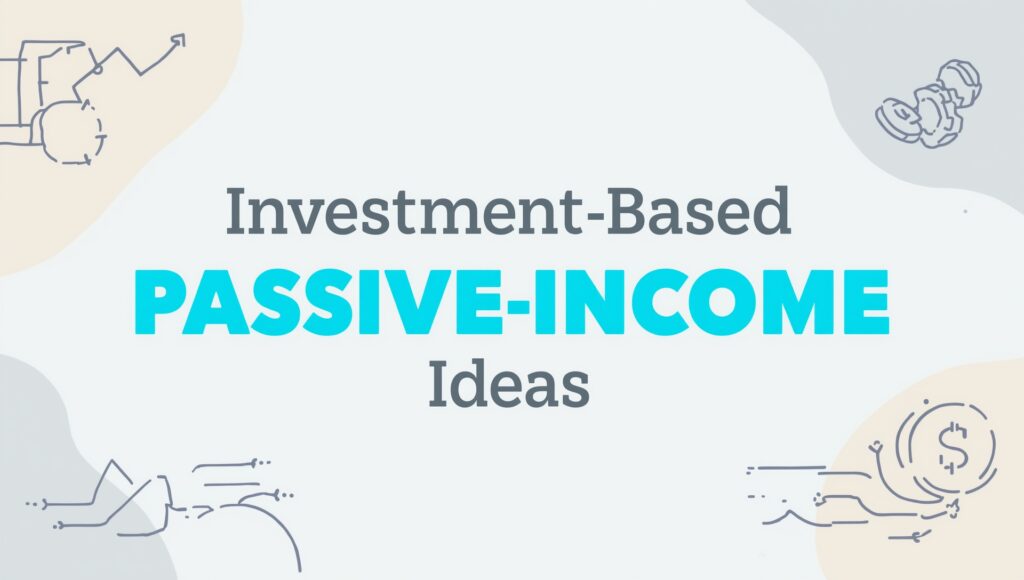The Ultimate Guide to Investment-Based Passive Income Ideas for 2025
In today’s economy, building multiple streams of income is essential for financial security and independence. Investment-based passive income allows you to grow wealth without constantly trading time for money. It’s about making your money work for you, letting compounding returns and smart strategies build sustainable wealth over the long term.
In this guide, we’ll explore a range of investment-based passive income ideas — from traditional strategies to modern innovations — along with practical tips on how to implement them.

✅ 1. Dividend Stocks – Grow Wealth with Regular Payouts
What are Dividend Stocks?
Dividend stocks are shares of companies that distribute a portion of their profits to shareholders as dividends. You earn money simply by holding the stock, and if you reinvest the dividends, your portfolio can grow exponentially over time.
How It Works:
- Companies pay out dividends quarterly or annually.
- You continue to earn as long as you hold the shares.
- Reinvesting dividends accelerates your growth through compounding.
Pros:
✔ Steady income
✔ Potential for long-term capital appreciation
✔ Can be started with relatively small investments
Risks:
⚠ Stock prices can fluctuate
⚠ Dividends are not guaranteed
How to Get Started:
- Choose established companies with a history of dividend payments (e.g., Johnson & Johnson, Procter & Gamble).
- Look for dividend yield, payout ratio, and debt levels.
- Diversify across sectors to reduce risk.
✅ 2. Real Estate Investment Trusts (REITs) – Real Estate Made Simple
What are REITs?
REITs allow you to invest in real estate properties like shopping malls, office buildings, or apartments without the hassle of direct ownership. They pay out most of their taxable income as dividends to investors.
How It Works:
- You buy shares in a trust that owns real estate assets.
- You earn regular income from rent, leases, or property appreciation.
Pros:
✔ Access to real estate without large capital
✔ Passive income through dividends
✔ Portfolio diversification
Risks:
⚠ Property market fluctuations
⚠ Interest rate sensitivity
How to Get Started:
- Invest through online brokers or mutual fund platforms.
- Choose REITs with diversified portfolios and strong occupancy rates.
- Understand sector-specific risks (commercial, residential, healthcare).
✅ 3. Peer-to-Peer Lending – Become the Bank
What is Peer-to-Peer (P2P) Lending?
P2P lending platforms connect investors directly with borrowers. Instead of parking money in a savings account, you lend it and earn interest as the borrower repays over time.
How It Works:
- You invest in loans based on borrower profiles.
- Returns are paid monthly or quarterly based on agreed interest rates.
Pros:
✔ Higher returns than traditional accounts
✔ You decide how much to invest and in which loans
✔ Supports entrepreneurs and small businesses
Risks:
⚠ Loan defaults
⚠ Lack of liquidity
How to Get Started:
- Use regulated platforms like LendingClub, Prosper, or Upstart.
- Diversify across multiple loans to mitigate default risk.
- Review borrower ratings and purpose for the loan.
✅ 4. Index Funds and ETFs – Smart, Low-Maintenance Investing
What are Index Funds and ETFs?
Index funds and ETFs track entire markets or sectors, such as the S&P 500 or Nasdaq. They provide exposure to a wide range of companies and are ideal for passive investors.
How It Works:
- You invest in a fund that mirrors a market index.
- Your investment grows with market appreciation and dividends.
Pros:
✔ Low cost and high diversification
✔ Historically stable returns
✔ Easy to automate
Risks:
⚠ Market downturns
⚠ Sector-specific volatility
How to Get Started:
- Choose funds with low expense ratios.
- Set up recurring monthly investments.
- Review performance annually and rebalance if needed.
✅ 5. Bonds and Fixed-Income Securities – Stability with Predictable Returns
What are Bonds?
Bonds are loans you give to governments or corporations in exchange for periodic interest payments and the return of principal at maturity.
How It Works:
- You earn fixed interest over a set period.
- Upon maturity, your initial investment is returned.
Pros:
✔ Safer than stocks
✔ Predictable income
✔ Can stabilize your portfolio during market downturns
Risks:
⚠ Inflation risk reduces real returns
⚠ Credit risk if the issuer defaults
How to Get Started:
- Diversify between government and corporate bonds.
- Ladder investments by maturity dates.
- Consider bond ETFs for easier access.
✅ 6. Cryptocurrency Staking – Modern Passive Income
What is Crypto Staking?
Staking involves locking cryptocurrencies in a network to support blockchain operations like transaction validation. In return, you earn staking rewards.
How It Works:
- You deposit crypto assets into staking pools.
- You earn rewards proportional to your stake.
Pros:
✔ High potential returns
✔ Supports emerging technology
✔ Opportunity for portfolio diversification
Risks:
⚠ Extreme price volatility
⚠ Platform security concerns
⚠ Regulatory risks
How to Get Started:
- Use established networks like Ethereum, Solana, or Cardano.
- Secure your wallet with hardware or multi-signature solutions.
- Understand lock-up periods and fees.
✅ 7. Automated Investment Platforms (Robo-Advisors) – Hassle-Free Growth
What are Robo-Advisors?
Robo-advisors use algorithms to create and manage diversified portfolios based on your risk appetite and financial goals. You invest, and the platform handles everything else.
How It Works:
- You input your risk profile and goals.
- Algorithms handle asset allocation and rebalancing.
- Automated plans help you stay consistent.
Pros:
✔ Easy for beginners
✔ Low fees compared to financial advisors
✔ No manual research required
Risks:
⚠ Lack of human oversight
⚠ May not handle complex tax strategies
How to Get Started:
- Platforms like Betterment, Wealthfront, or Vanguard Digital Advisor are popular choices.
- Set monthly auto-investments.
- Review your portfolio periodically.
✅ 8. Closed-End Funds and Preferred Stocks – Advanced Income Strategies
What are Closed-End Funds (CEFs)?
CEFs are actively managed funds with a fixed number of shares that trade on stock exchanges. They often invest in bonds, real estate, or international markets.
Preferred Stocks:
These are hybrid investments with features of both stocks and bonds, offering higher fixed dividends with priority over common stocks during liquidation.
Pros:
✔ Higher yields than common stocks
✔ Opportunity for tactical allocation
Risks:
⚠ Complex structures
⚠ Interest rate and credit risks
How to Get Started:
- Research the fund’s management history.
- Understand discount/premium pricing.
- Use as part of a diversified portfolio.
✅ 9. High-Yield Savings Accounts and CDs – Safe but Steady Income
What are High-Yield Savings Accounts and CDs?
These are bank products offering better interest rates than traditional accounts, with fixed durations (in CDs) or flexible access (in savings accounts).
How It Works:
- Money earns interest over time.
- CDs offer fixed rates for a predetermined period.
Pros:
✔ No market risk
✔ Ideal for short-term savings
✔ FDIC insured (up to $250,000)
Risks:
⚠ Lower returns than stocks
⚠ Inflation risk over time
How to Get Started:
- Compare rates between banks and credit unions.
- Ladder CDs to balance liquidity and yield.
- Use for emergency funds or conservative investments.
✅ 10. Annuities – Guaranteed Income for Retirement
What are Annuities?
Annuities are insurance products that provide guaranteed payments for life or a fixed term in exchange for a lump sum or periodic investment.
How It Works:
- You invest upfront and choose payout schedules.
- Payments can begin immediately or after a deferral period.
Pros:
✔ Guaranteed income
✔ Tax-deferred growth
✔ Helps plan for longevity risk
Risks:
⚠ High fees
⚠ Less liquidity
⚠ Complex structures
How to Get Started:
- Consult a licensed financial advisor.
- Compare fixed vs. variable annuities.
- Use as a retirement income tool, not your entire strategy.
Final Thoughts
Investment-based passive income isn’t just for the wealthy — it’s a smart approach that anyone can adopt with discipline and planning. By diversifying across assets like stocks, bonds, real estate, and newer opportunities like crypto staking, you can build a resilient income stream.
Start by setting clear goals, educating yourself, and consistently investing, even if it’s a small amount at first. Over time, compounding returns and disciplined investing will help you achieve financial independence.


